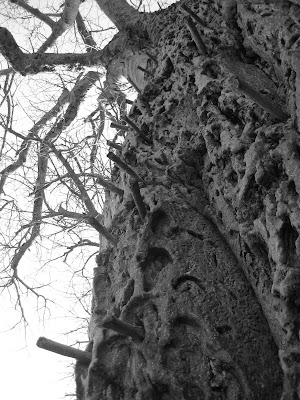On the docket for today were more field exercises in the WMA and the HALI project areas. We first went with Harrison to visit a Maasai village and do some bovine TB testing in their cattle. They use the same method as we're used to in human medicine in cattle--a subdermal comparative PPD test. They inject both avian and bovine TB, and compare the two responses after 72 hours. So this morning we did the initial injections, and someone else from the project would be back to measure the results in three days. The young Maasai man--an age group in which the men are collectively known as Moran--roped the first few cattle for us, using just a rope and a stick. He caught one hind leg with the rope wrapped around the stick, pulled the stick out, and cinched the rope around the leg. He pulled the rope until the cow couldn't walk, and sometimes this took two or three--or seven or eight, for one of the big bulls--other guys pulling the rope to stop the cow from running forward. Then he could wrap the rope around the other leg and with some help essentially knock the cow over onto its side. Boris and Dharmaveer also got a chance to catch the cows, and they didn't make it look nearly as easy as the Maasai guy did.
We caught a number of cows, and each person in our group got to try each job--shaving, measuring the initial skin fold area, injecting the PPD, and taking blood. The Maasai Mzee was there helping, and held off the jugular for us by jabbing his stick into the cows thoracic inlet in exactly the right place. The Maasai certainly know their cows.
After finishing testing, we sat down with the Mzee--Mzee Pastor Joshua--who was also the pastor of the christian church for the Maasai village. We had chai and talked to him about traditional Maasai culture, the changes he was experiencing in his household. He described the traditional male coming-of-age ceremony and ritual circumcision, which they continue to practice, and the tradition of the Moran--the strong, brave young men, from around age 14 to 35--going out to kill a lion on special occasions, which his household only rarely has been known to do but others still do more frequently. He explained how his younger kids--the ones attending compulsory primary school in the community, with a mixture of different tribes and cultures--no longer want to stretch their ears or drink fresh cow blood in ceremonies. He also told us about how the Tanzania Maasai met and agreed to stop practicing female circumcision, and about how there is no concept of rape in Maasai culture, because any man--married or no--is allowed to have sex with any woman he sees whenever he wants, and she can't say anything about it to anyone for risk of losing her ability to be married, and therefore her value in the society.
We finally left the village, and headed to our next exercise: walking a transect to look for signs and tracks of animals. We learned what the tracks and kinyesi (feces) looked like for lots of the common animals--dik-dik, duiker, jackel, baboon, tandala (kudu), fisi (hyena), mbwa mwitu (wild dog), twiga, civet cat, ngombe, mbuzi, nyati (buffalo), and kanga (guinea fowl).
Later that night, we plugged huge spotlights into the vans and Rovers, and went out for a night game drive. As the lead car, we were definitely able to see the most animals, since we spotted them before they ran off. We saw lots of dik-dik and bushbabies--which Boris made the mistake of calling "babybush," and the name seems to have stuck in our group. We also saw a few mongoose and genet cats, which were easier to spot because of their long black and white striped tails. We saw one twiga for a brief moment, and a few bushbuck. We also spotted a clearly domesticated housecat out far from any human settlements, and an angry muzungu (the word the locals use to mean any white --or even just not black--person, no matter their true ethnicity or nationality) man, who argued with us over what roads we were allowed to drive on and whether we could shine our spotlights around when he had guests in his camp for the night. We were out for nearly four hours, and by the end I was falling asleep between animal sightings.
Subscribe to:
Post Comments (Atom)






No comments:
Post a Comment